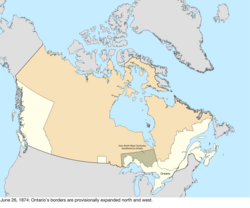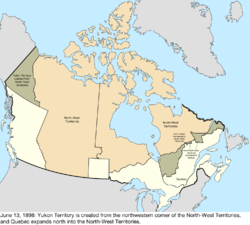| This article is part of a series on |
| Canadian Confederation |
|---|
 |
| Conferences |
| People |
| Related |
The history of post-confederation Canada began on July 1, 1867, when the British North American colonies of Canada, New Brunswick, and Nova Scotia were united to form a single Dominion within the British Empire. [1] Upon Confederation, the United Province of Canada was immediately split into the provinces of Ontario and Quebec. [2] The colonies of Prince Edward Island and British Columbia joined shortly after, and Canada acquired the vast expanse of the continent controlled by the Hudson's Bay Company, which was eventually divided into new territories and provinces. [3] Canada evolved into a fully sovereign state by 1982. [4]
Contents
Before being part of British North America, the constituents of Canada consisted of the former colonies of Canada and Acadia from within New France which had been ceded to Great Britain in 1763 as part of the Treaty of Paris. [5] French Canadian nationality was maintained as one of the "two founding nations" and legally through the Quebec Act which ensured the maintenance of the Canadian French language, Catholic religion, and French civil law within Canada, a fact which remains true today. [6]
Canada today has ten provinces and three territories; it only lost significant territory in the border dispute over Labrador with the Dominion of Newfoundland, which later joined Canada as the 10th province. [7]

































